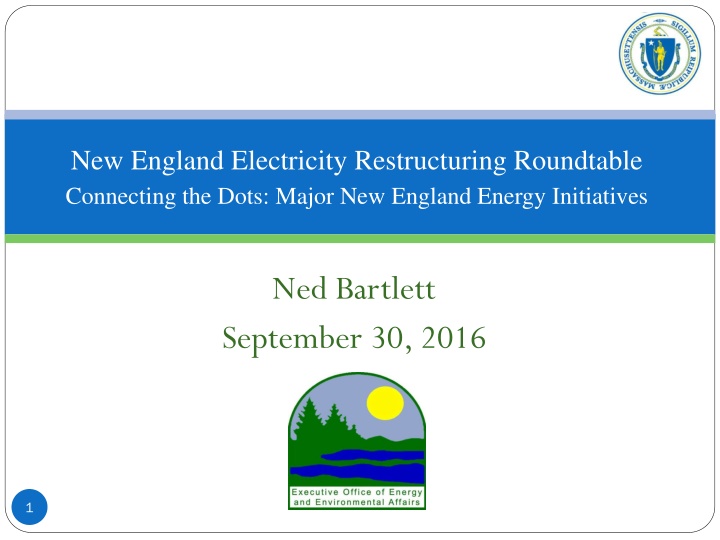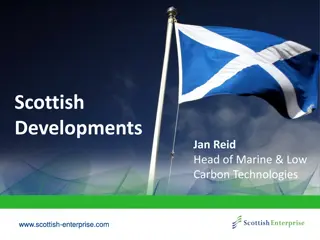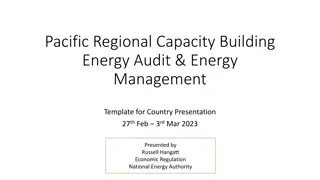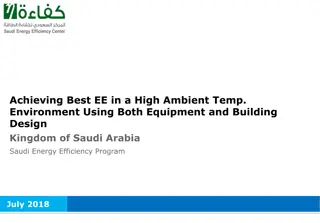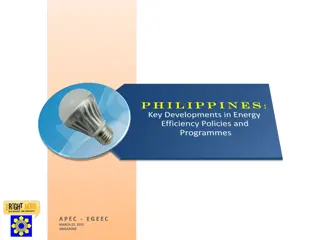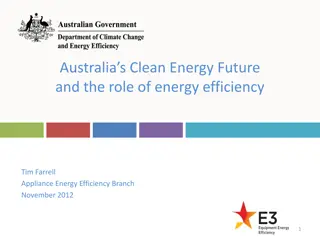New England Energy Initiatives Overview
Massachusetts has implemented significant energy initiatives in 2016, including solar legislation, offshore wind projects, and next-generation solar incentive programs. The state is focused on increasing renewable energy generation, improving net metering policies, and establishing long-term contracts for clean energy procurement.
Download Presentation

Please find below an Image/Link to download the presentation.
The content on the website is provided AS IS for your information and personal use only. It may not be sold, licensed, or shared on other websites without obtaining consent from the author.If you encounter any issues during the download, it is possible that the publisher has removed the file from their server.
You are allowed to download the files provided on this website for personal or commercial use, subject to the condition that they are used lawfully. All files are the property of their respective owners.
The content on the website is provided AS IS for your information and personal use only. It may not be sold, licensed, or shared on other websites without obtaining consent from the author.
E N D
Presentation Transcript
New England Electricity Restructuring Roundtable Connecting the Dots: Major New England Energy Initiatives Ned Bartlett September 30, 2016 1
Overview of Massachusetts Energy Issues in 2016 Chapter 75 of the Acts of 2016 An Act Relative to Solar Energy Chapter 188 of the Acts of 2016 - An Act Relative to Energy Diversity Executive Order 569 - Establishing an Integrated Climate Strategy for the Commonwealth SJC Decisions Kain v. Department of Environmental Protection (May, 2016) Engie Gas & LNG, LLC v. Department of Public Utilities (August, 2016) Release of State of Charge: MA Energy Storage Initiative NESCOE Mechanisms 2.0 Integrating Markets and Public Policies (IMAPP) NEPOOL Process RGGI and 3 State RFP 2
Solar Legislation and Next Generation Solar Incentive Program Chapter 75 of the Acts of 2016 An Act Relative to Solar Energy Increased public and private net metering caps by 3% each Created market net metering credit - reduces private net metering credit rate 40% Directed DOER to: Adopt rules and regulations that lower the cost of the commonwealth s solar incentive programs for ratepayers; and develop a statewide solar incentive program to encourage the continued development of solar renewable energy generating sources throughout the commonwealth Private net metering projects that apply for net metering after September 26, 2016 will receive the new market net metering credit rate Next Generation Solar Incentive Program Straw Proposal Released by DOER last Friday (9/23/16) at a public stakeholder meeting Proposal and audio from the meeting are available on DOER s website Ongoing stakeholder engagement meetings throughout the fall as DOER works to build consensus around the program design Written public comments accepted through Friday, October 28, 2016 Formal rulemaking and tariff proceedings at both DOER and the DPU are anticipated to start in early 2017 Targeting summer 2017 to launch the new incentive program 3
Chapter 188 of the Acts of 2016 - Offshore Wind & Clean Energy Generation Procurements Every distribution company shall jointly and competitively solicit proposals for offshore wind energy generation and clean energy generation, and provided reasonable proposals are received, shall enter into cost-effective long-term contracts. The distribution companies and the Department of Energy Resources (DOER) will jointly propose the timetable and method of the solicitations of long term contracts using a competitive bid process Determining reasonableness of proposals Role of Independent evaluator Department of Public Utilities (DPU) must: Review and approve the timetable and method of solicitations; and Approve all long term contracts and apportion cost among distribution companies 4
Solicitation Amounts and Procurement Deadlines Clean energy generation - approximately 9,450,000 megawatt-hours (MWh) or about 1200MW Solicit by April 1, 2017 Contract(s) no later than December 31, 2022 Offshore wind energy generation - approximately 1600 megawatts (MW) of aggregate nameplate capacity. Solicit by June 30, 2017 Contract(s) no later than June 30, 2027 Individual solicitations of no less than 400MW; Any subsequent solicitation shall occur within 24 months of a previous solicitation May coordinate and jointly issue solicitations with other New England states 5
Chapter 188 of the Acts of 2016 Energy Storage Provisions Section 8 - adds definition of Energy Storage System to G.L. c. 164 1 Section 9 - amends the definition of generation facility in G.L. c. 164 1 Section 15 - DOER voluntary determination on energy storage targets for electric companies 6
Executive Order 569 Establishing an Integrated Climate Strategy for the Commonwealth Section 1 instructs Secretary of Energy and Environmental Affairs to: (d) continue to lead on reform regional wholesale electric energy and capacity markets to ensure state mandates for clean energy are achieved in the most cost effective manner (e) publish within two years of signing this Order a comprehensive energy plan (f) ensure efforts to meet GHG emissions limits are consistent with and supportive of efforts to prepare for and adapt to the impacts of climate change an extreme weather events. 7
Recent Massachusetts Supreme Judicial Court Decisions Kain v. Department of Environmental Protection (May 2016) Interprets 3(d) of the MA Global Warming Solution Act (G.L. c. 21N) 3(d) provides that DEP shall promulgate regulations establishing a desired level of declining annual aggregate emission limits for sources or categories of sources that emit greenhouse gas emissions. Engie Gas & LNG, LLC v. Department of Public Utilities (August 2016) Interprets statutory language and purpose of G.L. c. 164, 94A Invalidated DPU Order approving ratepayer-backed, long-term contracts for natural gas pipeline capacity entered into by electric distribution companies 8
Energy Storage Initiative and Study $10 million initiative launched in 2015 State of Charge study Demonstration projects Robust stakeholder engagement Study details: Massachusetts will continue to lead the way on clean energy, energy efficiency, and the adoption of innovative technologies such as energy storage. Governor Baker, Feb 2016, Accord for a New Energy Future Press Event Technology and market landscape Comprehensive modeling of the cost and benefits of deploying storage Given the recent advances in energy storage technology and cost-effectiveness, it is hard to imagine a modern electric distribution system that does not include energy storage. Utility stakeholder perspective Economic use cases of specific storage applications Economic development opportunities Policy and program recommendations to grow storage deployment and industry in MA 9
Energy Study Recommendations The Commonwealth can nurture the energy storage industry and grow the deployment of storage in Massachusetts through programs and initiatives Funding for Demonstration projects Establish and Clarify Regulatory Treatment of Utility Storage Grant and Rebate Programs Storage in State Portfolio Standards Paired with Clean Energy procurements ISO Market Rules Initiatives to Grow Companies If adopted, the Study recommendations have the potential to yield: 600 MW of new energy storage by 2025 $800 million in cost savings to ratepayers 350,000 metric tons reduction in GHG emissions over a 10 year time span Equal to taking over 73,000 cars off the road 10
Forward Movement on State Policies + Wholesale Markets NEPOOL IMAPP NESCOE Mechanisms 2.0 State Plans and Activities 3. Litigation around wholesale market rules won t eliminate state energy and environmental laws 2. States must execute state laws as enacted by their legislatures 1. Competitive markets must accommodate state laws and policies in order for markets to be sustainable over the long- term 11
NESCOE Mechanisms 1.0 + 2.0 Continued analysis of a range of mechanisms that could support public policy resources, such as, for example: renewable portfolio & clean energy standards power purchase agreements strategic transmission investments centralized auction-based procurement Information at www.nescoe.com in the Resource Center Slide prepared and approved for use by NESCOE 12
Mechanisms 2.0 Analysis Scenario Analysis Mechanism Analysis Base Case Expanded RPS Clean Energy Imports Nuclear Retirements Combined Renewable and Clean Energy Alternative Transmission Mechanisms RPS CES PPA Strategic Transmission Centralized Procurement Others? Costs and Impacts Policy Goal Achievement Clean Energy Mechanisms 2.0 Study Fourth Quarter 2016 The production of information about hypothetical scenarios or mechanisms does not indicate and should not be interpreted as indicating any state or states preference for any particular scenario or mechanism. Further, hypothetical information is not a plan. It is simply information. Slide prepared and approved for use by NESCOE 13
Mechanisms 2.0 Analysis Approach Mechanism Analysis provides information to evaluate possible paths forward to meet objectives Renewable Portfolio Standard Scenario Analysis provides data only from predefined scenarios Clean Energy Standard Residual Revenue Requirements Prices Emissions Power Purchase Agreement Strategic Transmission Centralized Procurement Capacity Energy 14 Slide prepared and approved for use by NESCOE
Analysis, Studies and Discussion In Looking for Solutions Other stakeholder analysis Market participant, advocates ideas + proposals Discussion + debates NESCOE Clean Energy Mechanisms 2.0 Analysis NEPOOL Economic Study & Markets + Policies Discussion Market impact analysis Consumer impact analysis Solutions? Slide prepared and approved for use by NESCOE 15
